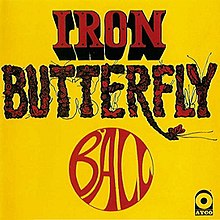| Ball | ||||
|---|---|---|---|---|
 | ||||
| Studio album by | ||||
| Released | January 17, 1969 | |||
| Recorded | 1968 | |||
| Studio | Gold Star, Hollywood The Hit Factory, New York City | |||
| Genre | ||||
| Length | 35:00 | |||
| Label | Atco | |||
| Producer | Jim Hilton | |||
| Iron Butterfly chronology | ||||
| ||||
| Singles from Ball | ||||
| ||||
Ball is the third studio album by the rock band Iron Butterfly, released on January 17, 1969. After the enormous success of In-A-Gadda-Da-Vida, Iron Butterfly modified its acid-rock sound somewhat and experimented with more melodic compositions. The band's trademark heavy guitars, however, are still evident on such tracks as "In the Time of Our Lives" and "It Must Be Love". The album reached number 3 on the Billboard 200 charts,[1] making Ball more immediately successful than In-A-Gadda-Da-Vida. In Canada the album reached number 4.[2] Ball was certified Gold in March 1969. It also spawned two minor hit singles: "Soul Experience", an uncharacteristically uplifting song for the group, went to number 75 on the Billboard charts and number 50 in Canada,[3][4] and despite its nightmarish musical tones and morbid lyrics, "In the Time of Our Lives" managed to reach number 96 and number 81 in Canada.[3][5][6] This is the second and final studio album to feature the famous lineup of Ingle, Bushy, Dorman and Brann.
In 1999, Collector's Choice Music released Ball with two bonus tracks, "I Can't Help But Deceive You Little Girl" and "To Be Alone", which were both recorded during the same era as Ball (although not necessarily during the same recording sessions) and were previously released as the two sides of a 7" single. "I Can't Help But Deceive You Little Girl" had also been released on the 1993 compilation Light & Heavy: The Best of Iron Butterfly.
- ^ "Billboard 200 - Iron Butterfly". Billboard. Retrieved September 24, 2017.
- ^ "RPM Top 50 Albums - April 21, 1969" (PDF).
- ^ a b "Billboard Hot 100 - Iron Butterfly". Billboard. Retrieved September 24, 2017.
- ^ "RPM Top 100 Singles - March 31, 1969" (PDF).
- ^ Joynson, Vernon (1995). Fuzz, Acid, & Flowers Archived August 25, 2011, at the Wayback Machine. London: Borderline Books.
- ^ "RPM Top 100 Singles - August 9, 1969" (PDF).